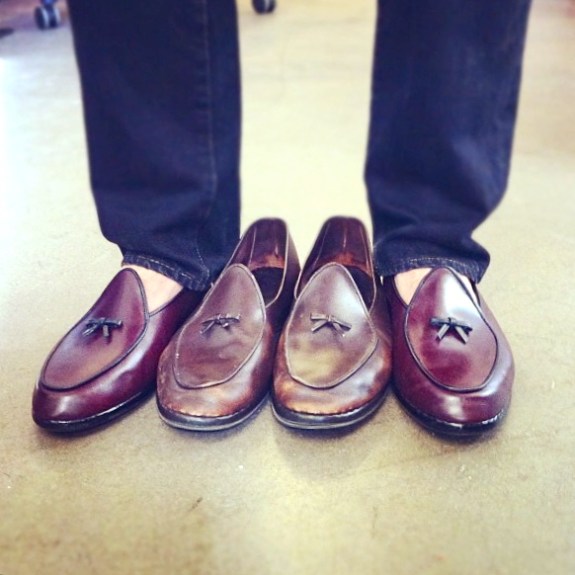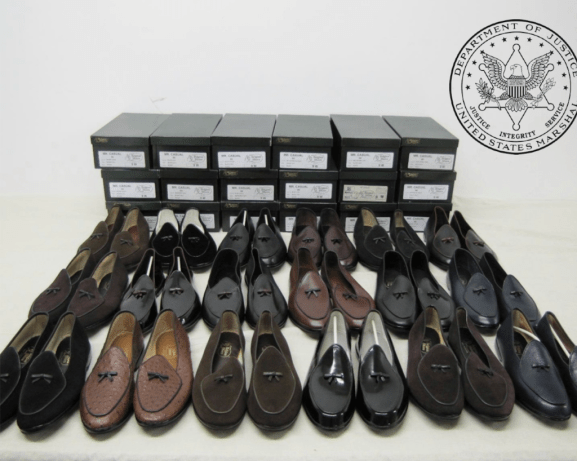
The Gucci bit loafer, the Prince Albert slipper and the Belgian loafer. Three loafers that all share the dubious honor of being “rakish,†or “revolting,†depending on who you ask. Polarizing as they may be, this traddy triumvirate has remained a constant curiosity throughout the years, as each style is rediscovered in time by whatever wave happens to be cresting that year.
First it was the Gucci bit loafer, which was thrust back into the spotlight during the East Coast preppy revival of the mid-aughts. The bit loaf had first gained notoriety during the mid-twentieth century as a high society hoof that was so popular amongst A-listers and deep-pocketed socialites that they became part of the Metropolitan Museum of Art’s collection in 1962. Similarly to Ralph Lauren, another Madison Avenue icon, the horsebit story begins with a vision of polo. The story goes that in the wake of WWI, the Italian born Guccio Gucci was working at London’s Savoy Hotel where polo was a persistent topic of conversation between the rotating roster of English aristocrats that frequented the hotel. As Gucci listened to (er, eavesdropped on) these tales from the ground, polo came to represent a leisurely and luxurious lifestyle that was always just out of reach.


Subsequently, when Gucci founded his eponymous label in the twenties, he laced his designs with many not so subtle nods to the game of polo. Despite the English equestrian influences and the shoe’s Italian construction, it was actually here in America that the bit loafer found their most receptive audience. The handsewn moccasin resonated with the East Coast elites, and by the 50’s the bit loafer had become a white collar staple.
Tides do turn though, and by the eighties the Gucci loafer came to represent the pretentious bravado of pastel wearing undesirables. From a sartorial standpoint, the shoe sat dormant for a decade plus (although to be fair, it never did lose it’s ironclad influence on unwavering preppy hotbeds like the UES, Palm Beach, and the Cape) before it was embraced by neo-trads who were infatuated by anything that once graced the pages of Take Ivy. While today the Gucci bit loafer is not as ubiquitous as it once was, it still remains a favorite of those men that could argue for hours about their favorite Whit Stilman movie, and are forever in search of a girlfriend named Muffy.
Next up is the Prince Albert slipper, which predictably can be attributed to a fellow by the name of Prince Albert. Prince Albert (or technically Prince Albert of Saxe-Coburg and Gotha) lived what is arguably one of the most carefree existences ever recorded in human history. As a consort to Queen Victoria during the 1800’s, Prince Albert officially held no actual authority, and unofficially was free to live like royalty minus all those pesky responsibilities. While Prince Albert did manage to accomplish some important feats in between his life of leisure, he is best known today for the aforementioned slippers that both bear his name and embody his lifestyle.
His original version, which featured a velvet exterior, a leather sole, and quite possibly a monogram of some sort, was a more luxurious take on the standard house slipper. Those velvet loafs instantly landed on the more garish side of the formal spectrum, becoming a favorite options for those aristocrats who did not fear a heavy dose of flamboyance. Prince Albert passed on in 1861, but for the next century his spirit lived on in the soles of those more daring dressers.
It was in the fifties and sixties (sensing a trend here?) that the American’s really adopted the Prince Albert, not just for those after hour affairs, but more notably as an off-the-clock slip on. Chalk it up to irreverence, or a rebellious streak, or a three-hundred year hangover from the Revolutionary War, but America’s menswear mavericks seemed determined to strip these traditional English slippers of their formal connotations. RFK famously wore them with a shetland sweater and khakis, Jack Lemmon loafed around in them off set, and artist David Hockney used to wear them in his studio, paint splatters and all.
Again, with the resurgence of puffed out prepdom the Prince Albert, albeit in even more obnoxious, go-to-hell iterations, became ever-more popular once again. While those loafers with their ostentatious insignias and cheeky motifs, might appeal to some, it’s the traditional loaf from English labels such as Tricker’s and Church’s that endures as the most classic, (and wearable) of all Prince Alberts. After all, it’s one thing to be rebellious with your footwear choices, it’s another to simply look ridiculous.

And finally, there’s Belgian shoes, those soft soled slippers that seem to defy all the laws of good taste. On paper, Belgians seem borderline goofy – they’re constructed with a bottom that is closer to a pillow than a sole, the brand itself dictates that they “should be worn outdoors on city pavement in dry weather only,†and come on they have little bows on them!
And yet, Belgians continue to surface again and again. They popped up in Club Monaco’s Fall 2012 campaign, Glenn O’Brien wore a blackwatch pair in a widely circulated GQ photoshoot (above), and Bernie Madoff (in)famously owned sixty-some-odd pair of the pricey slips (below.) Despite their recent surge of coverage, to this day, authentic Belgians can only be purchased at the brand’s sole store just off Park Avenue on 55th Street. That shop, with it’s carpeted floor and wooden racks is a high temple for ladies in Lilly Pulitzer and men who attended Exeter. To say that the shop is stuck in 1956, the year that Henri Bendel (yes, the nephew of that Henri Bendel) founded Belgian Shoes, wouldn’t be too far off. Truthfully though, it’s the brand’s aversion to change that has made them such a curiosity all these years.
Bendel’s Belgians are still handcrafted by a small team of craftswomen in the Belgian countryside using a three-hundred year old “turning†technique in which the shoe is stitched from the inside and then flipped once it’s completed. While the upswing in the shoe’s popularity is a welcome surprise, I imagine that the good people at Belgian are unfazed by the fact that the wave has suddenly caught up to them. In fifty plus years the brand hasn’t changed a thing, so why start now?
The larger question remains though, what is the appeal of these unconventional shoes? Is it their histories? Their air of elitism? Their contemporary recontextualization? The general cyclical nature of men’s clothing? I’d say that it’s a combination of all of these concepts, but it also has to do with a simple fact: dress shoes are boring. By and large, most men lean toward the more mundane side of footwear, and these three iconic loafers appear radical in comparison. Captoes, bucks, even brogues, these are staid, archaic, the sort of thing that you wear when you don’t want people to notice your feet. And so bit loafers, Prince Alberts, and Belgians, all provide another option. They are dressy, but more importantly they are showy, they cannot be ignored, and for this reason their appeal will never fade.








In fact, the Gucci loafer has been in the Met collection since 1973, and in the MoMA collection since 1985.
Here’s my take on these 3 “classics.” I have always hated the Guccis. In my old age, they’re now starting to grow on me a bit. I have thought of buying a pair as it seems as if it is something I should own, but I don’t think I like them enough to actually wear. I like the Albert slipper to wear around the house, perhaps with one of my Sulka robes(had to get that in there). However, wearing them outside in front of people is definitely an affected/gay look. As far as the Belgians go, with the leather soles they are not too gay looking, but the soft soled Belgians are gay looking, unless you are wearing them around the house, in which case they are not so gay looking. If you’re a straight man you definitely do not want to look gay, not that there is anything wrong with it.
As I am now out of London, I will probably not make it to the NYC store. Any word on where in Belgium the eponymous slippers are made? Buying an off brand pair made by the same workers in the same town is still quite authentic.
I find it hard not to comment on Lucy’s comment, however I shall hold my tongue. I don’t need to comment on how reprehensible it is. I don’t need to be the one to tell him that if a man is confident, anything looks natty. I similarly don’t need to be the one to point out the pop psychology theory of people that obsess about homosexuals, how they dress and act, and what that actually says about their hidden fears and desires. No. None of that. Let him call a pair of shoes “gay” three times in one sentence, “not that there is anything wrong with it”, eh?
Ok. I will comment: it’s THAT. Not IT. Please don’t misquote Seinfeld episodes.
Gucci loafers are naff. They should benchmark the price at 1/4th of whatever a Weston loafer sells for, because that’s about the size of the discrepancy in quality.
Alberts are great if you have the occasion to wear them.
I understand Lucy’s comment about the Belgians. I love the shoe, but it’s very much an Upper East Side decorator shoe that starts to look a bit off if one’s shoe size is above a 9 or one’s weight above 160#.
Gucci loafers: UK note.
Big in Essex. And The Den.
Wonderful read. I was unaware of the Belgian’s origin as a growing menswear enthusiast and over the last few months have grown more fond of them. While I’m a traditionalist with my wardrobe, I find myself more and more attracted to having statement pieces and I think these comfortable looking loafers fit right into what I might like.
Thanks Michael.
Grew up in Palm Beach and now live in SoCal. Been wearing Gucci loafers since 1980 and just love them. Never considered them out of style or ostentatious, just comfortable and easy to wear with anything.
I In this time of political correctness, the truth can’t be told without offending a whole group of people. I think Lucky was right on the money. There are many of us straight guys who want to dress well, but don’t want to look gay. I would like to attract as many women as possible, and I don’t think the gay look would achieve that goal. I have gone too far at times with my clothes, and have been asked by women (that I was interested in) “Are you gay?”. While a gay man (or Bobby) may find this comment just fine, I do not. It means I am not projecting the image that I want to project. That means I must be careful about what I wear and how I wear it. In my opinion that is what Lucky was expressing. Lucky did, not “obsess about homosexuals, how they dress and act as Bobby stated. .
Lucky, you and the people who think like you need to understand that not all people think like you. We don’t all think it is ok to look effeminate, and just because we don’t want to look effeminate does not mean we hate gays. It simply means that is not the image we want to project.